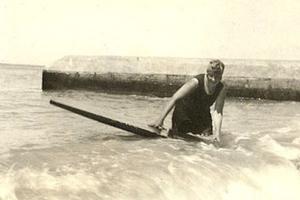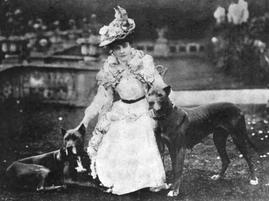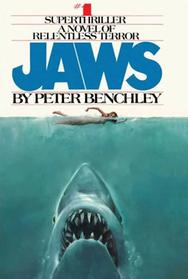
|
|
| Agatha Christie | |
What if we re-imagined legendary mystery writer and noted surfer Agatha Christie's novel The Man in the Brown Suit as a surfing-themed adventure story?
There was some perfectly entrancing bathing going on. The people had short curved boards and came floating in on the waves. It was far too early to go to tea. I made for the bathing pavilion, and when they said would I have a surfboard, I said 'Yes, please.' Surfing looks perfectly easy. It isn't. I say no more. I got very angry and fairly hurled my plank from me. Nevertheless, I determined to return on the first possible opportunity and have another go. I would not be beaten. Quite by mistake I then got a good run on my board, and came out delirious with happiness. Surfing is like that. You are either vigorously cursing or else you are idiotically pleased with yourself.
Agatha has set the theme. What happens next? That's where reconstructed reading comes in.
Imagine this: You're on vacation and all the books you brought along are read or abandoned. Fortunately, any summer lodging worthy of its tradition will have stray books left behind by previous visitors. They might not be irresistible, but could be reconstructible.
A century ago, the Atlantic Monthly (July 1922 issue) included a brief Contributors' Club piece headlined "Books as they are read." The anonymous writer (I think I'll call them Nony) observed: "People blessed with a stable residence are apt to think reading a simple matter. That is because they can select their books.... With an author of your own choice, there is no need for ingenuity. You begin with the first page and read to the end. His thought fits your mind as a made-to-measure suit fits your figure. But try one of those hand-me-down novels which find their way into the bookcases of the Continental pension, and see if it does not gall you into despair. These books are invariably left behind by transient locataires. Naturally, they take the good ones with them."

|
|
| Mrs. Henry de la Pasture | |
Nony suggests "the necessity of what I have called 'reconstruction.' Here's how it works: I pick up a copy of The Grey Knight by Mrs. Henry de la Pasture... and read the opening paragraph: "A woman rested upon a bench placed beneath a gayly striped awning in the front court of a small French provincial hotel."
Nony is unimpressed. "Obviously it won't do. The woman and the bench are the only substantives unescorted by adjectives in the whole sentence. Invidious distinction.... I skip to the middle of page 138, as I should have done in the first place, and read:
"Anna, before I go, won't you congratulate me and say you are glad?"
"Glad isn't the word," said Anna gruffly. "It's a load off my mind. I don't think you're the sort of person who is suited to live alone, and any kind of husband is better for you than none."
"That's better," Nony writes. "One is interested in Anna immediately. We must look for more of her, and turn, say, to page 195: 'She has been in the chapel, which is like an ice house; that's why Margaret went in there. Something has happened.' It says nothing about Anna.... One thing is certain, however: that delightful 'something has happened' refers to something satisfyingly material--a throat cut, a body hanged, a fainting fit at the very least.... But isn't the book already vastly improved? How far have we come from the striped awnings beneath which nothing can happen? Intended by the author for a hammock tale, we have transformed it into a detective story, fit to be read in the dead of winter before an open fire."
Nony believes that it is one of the cardinal principles of "reconstruction" to leave out the hero and heroine parts entirely: "The subordinate characters and wicked people--unless one of the latter chances to be a regular 'heavy'-- have some traces of humanity. But the hero and the heroine--no amount of skipping backward and forward suffices usually to save them."
 Reconstructing books you don't want to read cover to cover could become a new summer tradition. Imagine Peter Benchley's novel Jaws from the perspective of Tom Cassidy, whose date is the Great White's Chapter 1 victim. The couple were just partying at a beach house in Amity. Where does Tom go from that grisly moment? Nowhere. We've already forgotten him by chapter 4 as the body count rises.
Reconstructing books you don't want to read cover to cover could become a new summer tradition. Imagine Peter Benchley's novel Jaws from the perspective of Tom Cassidy, whose date is the Great White's Chapter 1 victim. The couple were just partying at a beach house in Amity. Where does Tom go from that grisly moment? Nowhere. We've already forgotten him by chapter 4 as the body count rises.
Flip to page 175: "He couldn't speak. He wanted to stand and walk out to the kitchen, but he didn't trust his legs. He'd never make it without holding on to something. Just sit still, he told himself. It'll pass." It's not Tom, but maybe it could be in a reconstructed Jaws.
Or... what if we brought Tom and Agatha together? "I learned to become expert--or at any rate expert from the European point of view--the moment of complete triumph on the day that I kept my balance and came right into shore standing upright on my board!" Christie wrote in her autobiography. In a surfing adventure/redemption novel, maybe she could help Tom get his sea legs back.
As Nony suggested a century ago, "try the method over on your own library.... Browning once spoke of 'sundry verses of St. Paul, which, read directly, sanctify the soul, but muttered backwards cure the gout and stone.' (I quote from memory). The transforming influence of reconstructive reading was never better set forth."

